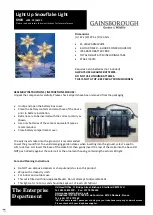
8
Never leave the driver's platform while driving!
The driving behaviour, steering and braking capacity are affected by mounted or towed implements
and ballast weights. For this reason, always ensure sufficient steering and braking capacity!
When driving in curves, take account of the wide radius and/or the centrifugal mass of the implement
(pay attention to the minimum turning curve)!
The implement may only be operated when all of the protective devices are installed and in safety
position!
It is forbidden to stand in the working area of the implement!
Do not stand near rotating and swivelling parts of the implement!
Hydraulic folding frames may only be actuated when nobody is standing in the swivelling range.
There are pinch and shear points on externally powered (e.g. hydraulic) parts!
On implements with manual folding, always ensure that the implement is stable!
For implements that are driven rapidly with soil-driven tools - Danger after lifting due to the still rotating
centrifugal mass! Only approach the implement when it has come to a standstill!
Before exiting the tractor, lower the implement onto the ground, switch off the motor and remove the
ignition key!
Standing between the tractor and the implement is forbidden unless the vehicle is secured against
rolling away using the parking brake and/or with wheel chocks!
Folded frames and lifting devices must be locked in transport position!
Packer catch arms must be swivelled in and locked before road transport!
Lock the track markers in transport position!
The view on the mounted harrow and the hazardous movement area must be clear to check the
procedure.
Cleaning is recommended as specified in the maintenance instructions (see point 8). The procedure
in in maintenance instruction must be observed and protective equipment must be used.
Working under the implement is forbidden
– especially when it is lifted.
The implements must be checked regularly by the operator (before every use) for any fractures and
cracks, chafe marks, leaks, loose bolts and connections, vibrations, unusual sounds, and to ensure
they function correctly.
Safety glasses and hearing protection should be used.
During assembly, the operator must ensure that the requirements for the tractor in terms of the power,
axle loads and weight distribution as specified in the operating manual are met and that the
connections specified in the operating instructions are made correctly.
When mounting the implement, the operator must ensure that connections to the tractor hydraulic
system are clean and carefully connected.
It must be ensured that the hydraulic couplings are not soiled.
When performing the work passes, the tractor's speed must maintained as specified in the operating
instructions. This can be between 1 and 12 km/h.
Additional lighting (e.g., flashlight) should be used for repair or maintenance work if necessary.
When implement parts are moving (e.g. during the folding or pre-tensioning procedure) it must be
ensured that there is no one standing in the danger zone of the implement
– there is a risk of crushing.
When driving through low or narrow obstacles (e.g. power lines, underpasses, etc.), attention must be
paid to the height and width of the implement to avoid collisions.
In case of loss or breakage of implement parts, they must be immediately replaced with original parts
by trained specialist personnel.
5.3
MOUNTED IMPLEMENTS
Before mounting and dismounting implements on the three-point linkage, the operating devices must
be moved into the correct position that excludes unintentional lifting or lowering!
For three-point mounting, the mounting categories of the tractor and the implement must match or be
adapted!
There is a risk of injury due to crushing and shearing points in the area of the three-point linkage!
Do not stand between the tractor and the implement when actuating the external controls for the three-
point mounting!









































